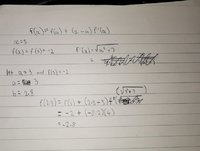You are using an out of date browser. It may not display this or other websites correctly.
You should upgrade or use an alternative browser.
You should upgrade or use an alternative browser.
Have I solved this Linear approximation question correctly?
- Thread starter Jared123
- Start date
Sorry about the mistakes. Still learning how to do linear approximation.I do have two concerns. First you wrote f(x) = f(3) which is not true. 2ndly you wrote f(2.8) = .... whis is also not true. At best f(2.8) ~ ....
Equal signs must be valid!
To answer the second half do I have to use the formula f'(x)=sqrt(x^2+7) which would mean -2.8 would be approximately equal to 3.852 which is the same as 2.8.
I do have two concerns. First you wrote f(x) = f(3) which is not true. 2ndly you wrote f(2.8) = .... whis is also not true. At best f(2.8) ~ ....
Equal signs must be valid!
Steven G
Elite Member
- Joined
- Dec 30, 2014
- Messages
- 14,603
Your first mistake had nothing to do with linear approximation. Except for a constant function, f(x) depends on x (ie it has different values which depends on x) where f(3) is a real number, a constant. f(x)=f(3) is not true (unless f(x) is a constant). Your other mistake has to do with using equal signs (again!). As you wrote at the top of you page, f(x) ~ =..... which is correct. Then when you APPROXIMATED f(2.8) you wrote f(2.8) =...Sorry about the mistakes. Still learning how to do linear approximation.
Steven G
Elite Member
- Joined
- Dec 30, 2014
- Messages
- 14,603
Either you are saying that -2.8 is the same as 3.853 or you are saying that 3.852 is the same as 2.8. Why would you say that! Those number are not equal to one another.To answer the second half do I have to use the formula f'(x)=sqrt(x^2+7) which would mean -2.8 would be approximately equal to 3.852 which is the same as 2.8.
First of all who is to say if your estimate is too large or too small? That is a matter of opinion. You could let x = 2.81, which would make x-a small, but you do not know what f(2.81) is as you do not have f(x)
What have you learned in class/textbook about solving such problems? Please post back.
pka
Elite Member
- Joined
- Jan 29, 2005
- Messages
- 11,978
The derivative is a limit so that: \(f'(a) = \mathop {\lim }\limits_{\Delta x \to 0} \dfrac{{f(a + \Delta x) - f(a)}}{{\Delta x}}\quad \Rightarrow \quad f(a + \Delta x) \approx f'(a)\Delta x + f(a)\)
This is known as the tangent line approximation of \(f\) near \(x=a\).
For this question \(f(2.8)\) we use \(a=3~\&~\Delta x=-0.2\)
It seems to me that your work is correct. As requested, please do post a final result.

